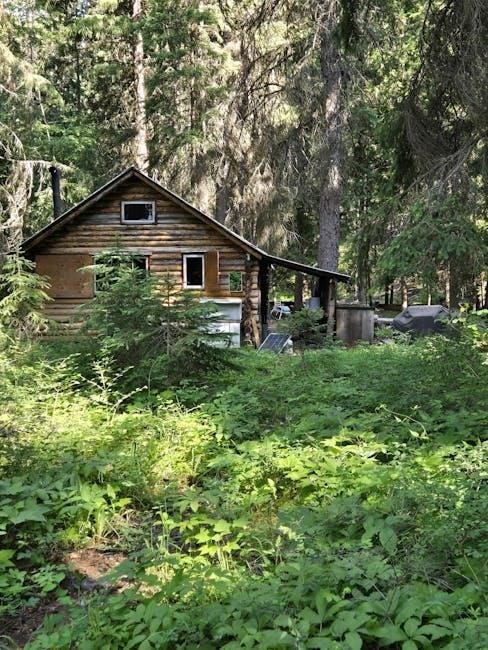Setting up a 10×20 canopy requires careful planning and adherence to instructions to ensure safety and stability. This guide provides step-by-step directions for a successful setup.

1.1 Importance of Following Instructions
Following the instructions for a 10×20 canopy setup is crucial for safety‚ stability‚ and longevity. Proper assembly ensures the structure withstands environmental stresses like wind and rain. Deviating from guidelines can lead to accidents or damage. Always read the manual thoroughly and adhere to the steps to guarantee a secure and efficient setup. This prevents potential risks and ensures optimal performance.
1.2 Overview of 10×20 Canopy Setup
A 10×20 canopy setup involves assembling a durable frame with a sturdy tarp‚ designed for temporary use. Key components include galvanized pipes‚ corners‚ and a UV-rated tarp. The process requires laying out parts‚ constructing the frame‚ and securing the tarp. Ensure the setup is on a smooth‚ level surface and avoid windy‚ rainy‚ or snowy conditions to maintain stability and safety.
Essential Components of the 10×20 Canopy
The canopy includes a galvanized pipe frame‚ 3-way and 4-way corners‚ bungee ties‚ and a UV-rated tarp. These components ensure durability and weather resistance.
2.1 List of Parts and Materials
The 10×20 canopy includes 16 pieces of 58″ galvanized pipe and 9 pieces of 66″ galvanized pipe for the frame. It also comes with 6 three-way corners and 6 four-way corners for structural support. A 12×20 UV-rated tarp is provided for the canopy top. Additional materials include bungee ties for securing the tarp and curtain clips for attaching the sides. Ensure all parts are included before starting assembly.
2.2 Understanding the Frame and Tarp Structure
The 10×20 canopy frame is constructed using galvanized pipes and connectors‚ forming a durable structure. The tarp‚ typically UV-rated and waterproof‚ is designed to fit securely over the frame. It attaches using bungee ties and clips‚ ensuring a tight and even surface. The tarp’s size slightly exceeds the frame dimensions for a snug fit‚ while its material ensures protection against weather conditions and prolonged sun exposure.

Safety Precautions and Warnings
Always avoid setting up on steep inclines or in windy‚ rainy‚ or snowy conditions. Never let water or snow accumulate on the tarp‚ as it may collapse the structure. Ensure proper anchoring to prevent the canopy from acting like a kite in the wind‚ and keep all heat sources away from the fabric to avoid fire hazards.
3.1 General Safety Guidelines
Ensure the canopy is set up on a flat‚ smooth surface‚ avoiding steep inclines. Wear gloves during assembly to protect hands. Never assemble in windy‚ rainy‚ or snowy conditions‚ as this can lead to instability. Avoid using heat sources near the tarp‚ as it may not be fireproof. Keep the area clear of obstacles and ensure all anchors are securely tightened to prevent collapse or movement.
3.2 Environmental Considerations (Wind‚ Rain‚ Snow)
Avoid setting up the canopy in windy conditions‚ as it may act like a kite and cause instability. Never assemble in rain or snow‚ as moisture can weaken the structure. Ensure no water or snow accumulates on the tarp‚ as this can lead to collapse. Periodically inspect anchors to maintain stability and prevent damage from environmental stressors like strong winds or freezing temperatures.
Preparation Before Assembly
Before assembling your 10×20 canopy‚ ensure all parts are present and undamaged. Choose a smooth‚ flat surface and gather all necessary tools and accessories for the setup.

4.1 Choosing the Right Location
Select a flat‚ smooth surface for your 10×20 canopy‚ avoiding steep inclines and uneven ground. Ensure the area is clear of obstacles and overhead obstructions. Avoid setting up in windy‚ rainy‚ or snowy conditions to prevent damage and ensure stability. The location should also provide easy access for securing the canopy with anchors or weights to prevent it from being lifted by wind. Proper positioning ensures safety and extends the canopy’s lifespan.
4.2 Gathering Tools and Accessories
Before assembling your 10×20 canopy‚ gather all necessary tools and accessories‚ such as a ladder‚ gloves‚ and wrenches. Ensure you have all hardware‚ ropes‚ and anchors included in the kit. Review the manual to confirm you have everything needed. Having all materials ready will streamline the assembly process and prevent delays. This preparation ensures a smooth and efficient setup experience.
Step-by-Step Assembly Process
Begin by organizing all parts‚ then construct the frame from the center outward. Attach the tarp securely‚ ensuring tight fitting. Follow each step carefully for stability.
5.1 Layout and Organizing Parts
Lay out all components on a flat surface to identify and organize them. Start with the corners and pipes‚ ensuring all pieces are accounted for. Separate similar parts to avoid confusion. Arrange the frame components in the order they will be assembled‚ beginning with the center ridge. Check for completeness to prevent delays during assembly. This step ensures a smooth and efficient setup process.
5.2 Constructing the Frame
Begin by assembling the frame‚ starting with the center ridge. Connect the 9′ 6″ galvanized pipes to form the length of the canopy. Attach the 6′ 3″ pipes to the corners and legs. Use the 3-way and 4-way connectors to secure the frame structure. Ensure all joints are tightly fitted and the frame is square. Double-check the connections for stability before moving on to the next step.

5.3 Attaching the Tarp to the Frame
Align the center of the tarp with the frame’s ridge‚ ensuring even distribution. Secure the tarp to the frame using side release buckles along the perimeter. Tighten the bungee ties to ensure a snug fit. Attach the curtain clips to the legs for added stability. Ensure the tarp is tightly secured to prevent flapping in the wind. Double-check all connections for a secure and even fit.

Anchoring and Securing the Canopy

Secure the canopy using ropes‚ anchors‚ and accessories. Ensure the ground is smooth and check anchors periodically for stability. This prevents wind damage and ensures safety.
6.1 Proper Anchoring Techniques
Properly anchor your 10×20 canopy by using ropes and stakes. Ensure the ground is smooth and level. Use high-quality stakes and tighten ropes firmly. Check anchors regularly to maintain stability. Avoid setting up on steep inclines or in windy conditions. Use bolted cement wedge lags for added security. This prevents the canopy from acting like a kite in the wind. Always follow manufacturer instructions for securing the structure. Ensure all corners are tightly fastened to prevent any movement. Regularly inspect the anchors to ensure they remain secure‚ especially after weather changes. Proper anchoring is crucial for safety and longevity of the canopy. By following these steps‚ you can ensure your canopy remains stable and secure in various conditions. Avoid common mistakes like loose anchoring‚ which can lead to damage or collapse. Always consider the environment and adjust anchoring techniques accordingly. This will help extend the life of your canopy and provide reliable shelter. Remember‚ a well-anchored canopy is safer and more durable. Take the time to secure it properly for optimal performance. Proper anchoring techniques are essential for any successful canopy setup. Ensure all steps are followed carefully to avoid potential risks. Your safety and the canopy’s stability depend on it. Always prioritize secure anchoring to enjoy your canopy without worries.
6.2 Ensuring Stability and Balance
Ensure the canopy’s stability by checking the frame for levelness and tightening all bolts securely. Use weights or sandbags to balance the structure‚ especially on uneven surfaces. Adjust the legs to maintain even ground contact. Regularly inspect the frame for any signs of wear or damage. Proper balance prevents swaying and ensures the canopy remains upright. Always maintain even weight distribution to avoid tipping. Check the tarp for tightness to prevent flapping‚ which can disrupt balance. Ensure all parts are aligned correctly for optimal stability. Avoid overloading the canopy with heavy objects. Regular maintenance helps maintain balance and structural integrity. Keep the canopy stable by addressing any imbalances promptly. This ensures safety and prolongs the canopy’s lifespan. Always verify stability after assembly and before use. A balanced canopy provides reliable shelter and protection. Take the time to ensure it is stable and secure. Proper balance is key to enjoying your canopy safely. Regular checks and adjustments are essential. Maintain stability to ensure the canopy remains functional and secure. Always prioritize balance for optimal performance. A stable canopy is a safe and reliable shelter solution. Ensure balance and stability at all times. This guarantees the canopy’s effectiveness and durability. Regularly monitor and adjust as needed; Stability is crucial for any successful canopy setup. Always ensure the structure is balanced and secure. Your safety depends on it. A stable canopy is a safe canopy. Always verify balance before use. Proper stability ensures the canopy remains standing in various conditions. Take the time to ensure it is balanced correctly. A well-balanced canopy is essential for safety and performance. Always check stability and balance regularly. This ensures the canopy remains secure and functional. Stability and balance are vital for any canopy setup. Always ensure the structure is properly balanced. Your safety and the canopy’s longevity depend on it. Take the time to ensure stability and balance. Proper balance ensures the canopy remains stable and secure. Always check and adjust as needed. A balanced canopy is a safe and reliable shelter. Ensure stability and balance for optimal performance. Regularly inspect and maintain the structure. Stability and balance are essential for any successful canopy setup. Always ensure the canopy is properly balanced; Your safety and the structure’s integrity depend on it. Proper balance ensures the canopy remains stable and secure. Always check and adjust as needed. A well-balanced canopy is a safe and reliable shelter. Ensure stability and balance for optimal performance. Regularly inspect and maintain the structure. Stability and balance are essential for any successful canopy setup. Always ensure the canopy is properly balanced. Your safety and the structure’s integrity depend on it. Proper balance ensures the canopy remains stable and secure. Always check and adjust as needed. A well-balanced canopy is a safe and reliable shelter. Ensure stability and balance for optimal performance. Regularly inspect and maintain the structure. Stability and balance are essential for any successful canopy setup. Always ensure the canopy is properly balanced. Your safety and the structure’s integrity depend on it. Proper balance ensures the canopy remains stable and secure. Always check and adjust as needed. A well-balanced canopy is a safe and reliable shelter. Ensure stability and balance for optimal performance. Regularly inspect and maintain the structure. Stability and balance are essential for any successful canopy setup. Always ensure the canopy is properly balanced. Your safety and the structure’s integrity depend on it. Proper balance ensures the canopy remains stable and secure. Always check and adjust as needed. A well-balanced canopy is a safe and reliable shelter. Ensure stability and balance for optimal performance. Regularly inspect and maintain the structure. Stability and balance are essential for any successful canopy setup. Always ensure the canopy is properly balanced. Your safety and the structure’s integrity depend on it. Proper balance ensures the canopy remains stable and secure. Always check and adjust as needed. A well-balanced canopy is a safe and reliable shelter. Ensure stability and balance for optimal performance. Regularly inspect and maintain the structure. Stability and balance are essential for any successful canopy setup. Always ensure the canopy is properly balanced. Your safety and the structure’s integrity depend on it. Proper balance ensures the canopy remains stable and secure. Always check and adjust as needed. A well-balanced canopy is a safe and reliable shelter. Ensure stability and balance for optimal performance. Regularly inspect and maintain the structure. Stability and balance are essential for any successful canopy setup. Always ensure the canopy is properly balanced. Your safety and the structure’s integrity depend on it. Proper balance ensures the canopy remains stable and secure. Always check and adjust as needed. A well-balanced canopy is a safe and reliable shelter. Ensure stability and balance for optimal performance. Regularly inspect and maintain the structure. Stability and balance are essential for any successful canopy setup. Always ensure the canopy is properly balanced. Your safety and the structure’s integrity depend on it. Proper balance ensures the canopy remains stable and secure. Always check and adjust as needed. A well-balanced canopy is a safe and reliable shelter. Ensure stability and balance for optimal performance. Regularly inspect and maintain the structure. Stability and balance are essential for any successful canopy setup. Always ensure the canopy is properly balanced. Your safety and the structure’s integrity depend on it. Proper balance ensures the canopy remains stable and secure. Always check and adjust as needed. A well-balanced canopy is a safe and reliable shelter. Ensure stability and balance for optimal performance. Regularly inspect and maintain the structure.

Post-Assembly Checks
After assembly‚ inspect all connections‚ tighten any loose bolts‚ and ensure the tarp is securely attached. Verify the structure is level and evenly balanced.
7.1 Verifying All Connections
After assembling the 10×20 canopy‚ check every connection to ensure all parts are securely fastened. Inspect bolts‚ screws‚ and clips for tightness. Verify that the frame is sturdy and the tarp is evenly stretched. Double-check corner straps and bungee ties to prevent any loose areas. This step is crucial for stability and safety.
7.2 Final Safety Inspection
Conduct a thorough safety inspection of the 10×20 canopy to ensure all components are secure. Check for any signs of wear‚ loose parts‚ or damage to the tarp. Ensure the frame is level and stable‚ and all anchors are properly secured. Verify that no flammable materials are nearby‚ and the area is clear of obstacles. This final check ensures the canopy is safe for use.

Maintenance and Storage Tips
Regularly clean the 10×20 canopy with mild soap and water to prevent dirt buildup. Allow it to dry completely before storing. Store in a dry‚ pest-free area to maintain quality and longevity.
8.1 Cleaning and Preserving the Canopy
Regularly clean the 10×20 canopy using mild soap and water to remove dirt and stains. Avoid harsh chemicals or abrasive materials that may damage the fabric. Rinse thoroughly and allow to air dry completely to prevent mold or mildew buildup. For tougher stains‚ use a soft-bristle brush gently. Regular maintenance ensures the canopy remains durable and UV-resistant for extended use.
8.2 Proper Storage Methods
Store the 10×20 canopy in a dry‚ well-ventilated area to prevent moisture buildup. Disassemble and clean all parts before storing. Use the provided storage bag for the tarp and frame components. Keep all hardware and accessories organized in labeled containers. Avoid folding or creasing the tarp excessively to maintain its structural integrity. Proper storage extends the lifespan and ensures the canopy remains ready for future use.
Troubleshooting Common Issues
Address loose parts by tightening hardware and ensure the tarp is securely attached. Check for water pooling and adjust the frame to prevent accumulation.

Leave a Reply
You must be logged in to post a comment.